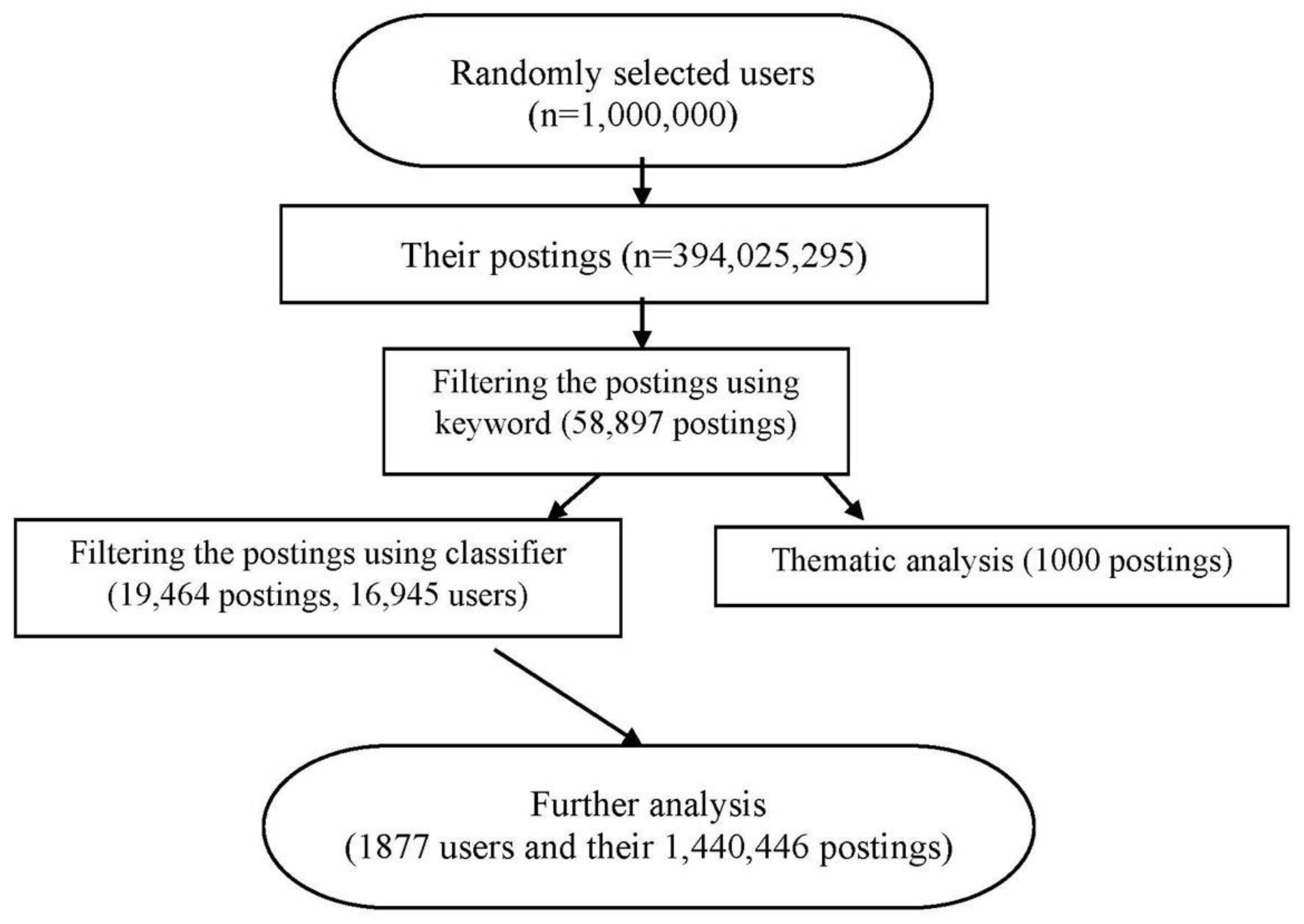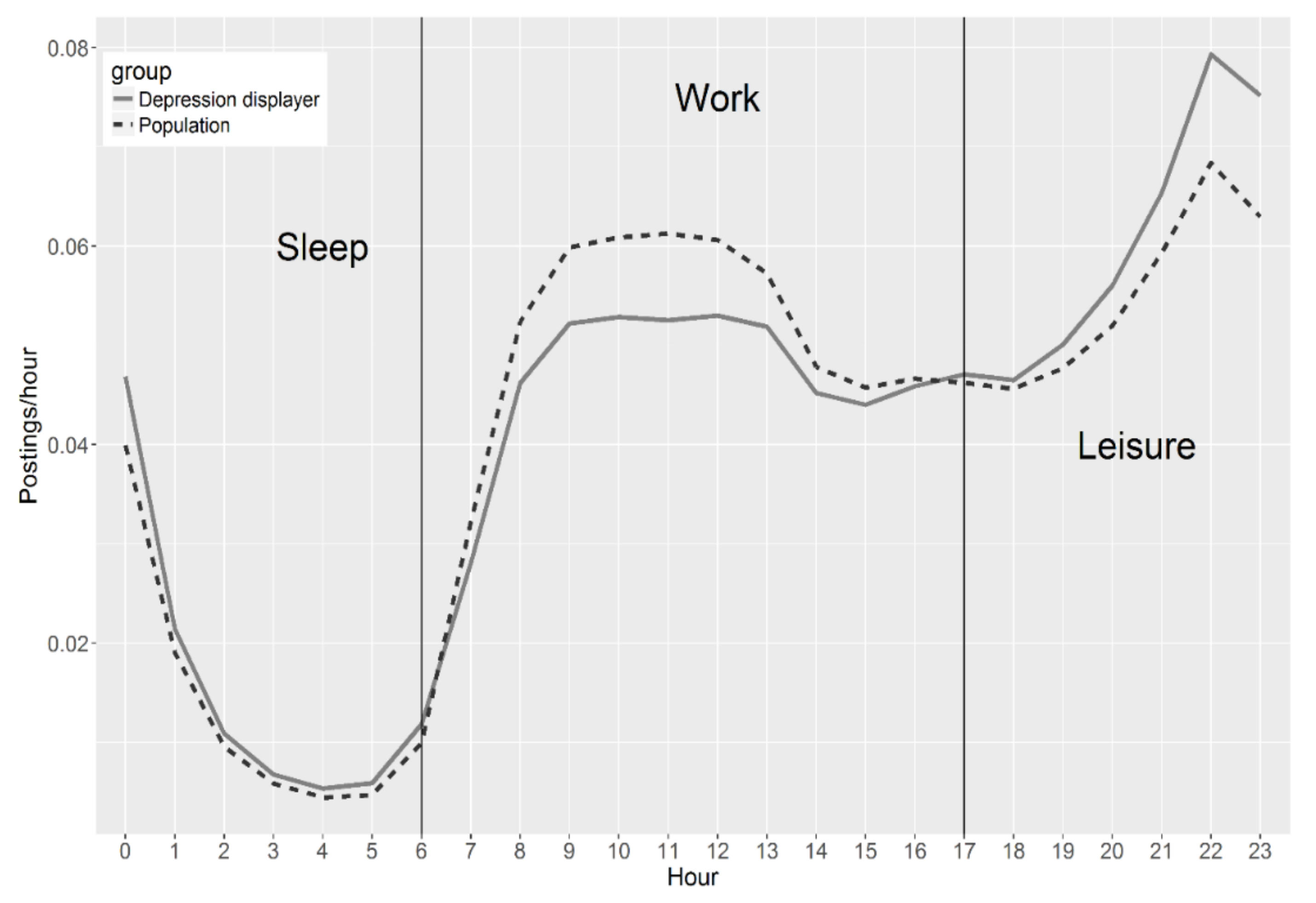Characterizing Depression Issues on Sina Weibo
Abstract
:1. Introduction
2. Methods
2.1. Data Collection
2.2. Thematic Analysis
2.3. Building a Classifier
2.4. Demographic Characteristics
2.5. Diurnal Patterns
2.6. Patterns of Emoticon Usage
3. Results
3.1. Thematic Analysis
3.2. Demographic Characteristics
3.3. Diurnal Patterns
3.4. Pattern of Emoticon Usage
4. Discussion
5. Conclusions
Acknowledgments
Author Contributions
Conflicts of Interest
References
- Sina Weibo Data Center. Weibo User Development Report; Sina Weibo: Beijing, China, 2013. [Google Scholar]
- Wilson, M.L.; Ali, S.; Valstar, M.F. Finding information about mental health in microblogging platforms: A case study of depression. In Proceedings of the 5th Information Interaction in Context Symposium, Regensburg, Germany, 26–28, August 2014; ACM: New York, NY, USA, 2014. [Google Scholar]
- Liu, S.; Young, S.D. A survey of social media data analysis for physical activity surveillance. J. Forensic Legal Med. 2016. [Google Scholar] [CrossRef]
- Chung, S.; Liu, S. Predicting Stock Market Fluctuations from Twitter; University of California, Berkeley: Berkeley, CA, USA, 2011. [Google Scholar]
- Tian, X.; Yu, G.; He, F. An analysis of sleep complaints on Sina Weibo. Comput. Hum. Behav. 2016, 62, 230–235. [Google Scholar] [CrossRef]
- Han, J.; Tian, X.; Yu, G.; He, F. Disclosure Pattern of Self-Labeled People Living with HIV/AIDS on Chinese Social Networking Site: An Exploratory Study. Cyberpsychol. Behav. Soc. Netw. 2016, 19, 516–523. [Google Scholar] [CrossRef] [PubMed]
- Morris, M.R.; Teevan, J.; Panovich, K. What do people ask their social networks, and why? A survey study of status message Q&A behavior. In Proceedings of the SIGCHI Conference on Human Factors in Computing Systems, Atlanta, GA, USA, 10–15 April 2010; ACM: New York, NY, USA, 2010. [Google Scholar]
- Han, G.; Wang, W. Mapping user relationships for health information diffusion on microblogging in China: A social network analysis of Sina Weibo. Asian J. Commun. 2015, 25, 65–83. [Google Scholar] [CrossRef]
- Wang, Z.; Yu, G.; Tian, X.; Tang, J.; Yan, X. A study of users with suicidal ideation on Sina Weibo. Telemed. J. e-Health 2018. [Google Scholar] [CrossRef] [PubMed]
- Guntuku, S.C.; Yaden, D.B.; Kern, M.L.; Ungar, L.H.; Eichstaedt, J.C. Detecting depression and mental illness on social media: An integrative review. Curr. Opin. Behav. Sci. 2017, 18, 43–49. [Google Scholar] [CrossRef]
- Mathers, C.D.; Loncar, D. Projections of global mortality and burden of disease from 2002 to 2030. PLoS Med. 2006, 3, e442. [Google Scholar] [CrossRef] [PubMed]
- Compton, W.M.; Conway, K.P.; Stinson, F.S.; Grant, B.F. Changes in the prevalence of major depression and comorbid substance use disorders in the United States between 1991–1992 and 2001–2002. Am. J. Psychiatry 2006, 163, 2141–2147. [Google Scholar] [CrossRef] [PubMed]
- Kessler, R.C.; Berglund, P.; Demler, O.; Jin, R.; Koretz, D.; Merikangas, K.R.; Rush, A.J.; Walters, E.E.; Wang, P.S.; National Comorbidity Survey Replication. The epidemiology of major depressive disorder: Results from the National Comorbidity Survey Replication (NCS-R). JAMA 2003, 289, 3095–3105. [Google Scholar] [CrossRef] [PubMed]
- Lépine, J.-P.; Briley, M. The increasing burden of depression. Neuropsychiatr. Dis. Treat. 2011, 7 (Suppl. 1), 3–7. [Google Scholar] [PubMed]
- Sadeque, F.; Xu, D.; Bethard, S. Measuring the Latency of Depression Detection in Social Media. In Proceedings of the Eleventh ACM International Conference on Web Search and Data Mining, Los Angeles, CA, USA, 5–9 February 2018; ACM: New York, NY, USA, 2018. [Google Scholar]
- McIver, D.J.; Hawkins, J.B.; Chunara, R.; Chatterjee, A.K.; Bhandari, A.; Fitzgerald, T.P.; Jain, S.H.; Brownstein, J.S. Characterizing sleep issues using Twitter. J. Med. Internet Res. 2015, 17, e140. [Google Scholar] [CrossRef] [PubMed]
- Jamison-Powell, S.; Linehan, C.; Pearson, L.; Lawson, S. I can’t get no sleep: Discussing# insomnia on twitter. In Proceedings of the SIGCHI Conference on Human Factors in Computing Systems, Austin, TX, USA, 6–10 May 2012; ACM: New York, NY, USA, 2012. [Google Scholar]
- Guo, Y.; Goh, D.H.-L. “I Have AIDS”: Content analysis of postings in HIV/AIDS support group on a Chinese microblog. Comput. Hum. Behav. 2014, 34, 219–226. [Google Scholar] [CrossRef]
- Moreno, M.A.; Christakis, D.A.; Egan, K.G.; Jelenchick, L.A.; Cox, E.; Young, H.; Villiard, H.; Becker, T. A pilot evaluation of associations between displayed depression references on Facebook and self-reported depression using a clinical scale. J. Behav. Health Serv. Res. 2012, 39, 295–304. [Google Scholar] [CrossRef] [PubMed]
- Whitehill, J.M.; Brockman, L.N.; Moreno, M.A. “Just talk to me”: Communicating with college students about depression disclosures on Facebook. J. Adolesc. Health 2013, 52, 122–127. [Google Scholar] [CrossRef] [PubMed]
- Reavley, N.J.; Pilkington, P.D. Use of Twitter to monitor attitudes toward depression and schizophrenia: An exploratory study. PeerJ 2014, 2, e647. [Google Scholar] [CrossRef] [PubMed]
- Moreno, M.A.; Jelenchick, L.A.; Egan, K.G.; Cox, E.; Young, H.; Gannon, K.E.; Becker, T. Feeling bad on Facebook: Depression disclosures by college students on a social networking site. Depress. Anxiety 2011, 28, 447–455. [Google Scholar] [CrossRef] [PubMed]
- O’Dea, B.; Wan, S.; Batterham, P.J.; Calear, A.L.; Paris, C.; Christensen, H. Detecting suicidality on Twitter. Internet Interv. 2015, 2, 183–188. [Google Scholar] [CrossRef]
- Wang, W.; Liu, Y. Communication message cues and opinions about people with depression: An investigation of discussion on Weibo. Asian J. Commun. 2015, 25, 33–47. [Google Scholar] [CrossRef]
- Andreassen, C.S.; Billieux, J.; Griffiths, M.D.; Kuss, D.J.; Demetrovics, Z.; Mazzoni, E.; Pallesen, S. The relationship between addictive use of social media and video games and symptoms of psychiatric disorders: A large-scale cross-sectional study. Psychol. Addict. Behav. 2016, 30, 252–262. [Google Scholar] [CrossRef] [PubMed]
- Griffiths, M.D.; Kuss, D.J.; Demetrovics, Z. Social networking addiction: An overview of preliminary findings. In Behavioral Addictions; Elsevier: Amsterdam, The Netherlands, 2014; pp. 119–141. [Google Scholar]
- Hu, T.-W.; He, Y.; Zhang, M.; Chen, N. Economic costs of depression in China. Soc. Psychiatry Psychiatr. Epidemiol. 2007, 42, 110–116. [Google Scholar] [CrossRef] [PubMed]
- Hu, Q.; Li, A.; Heng, F.; Li, J.; Zhu, T. Predicting Depression of Social Media User on Different Observation Windows. In Proceedings of the 2015 IEEE/WIC/ACM International Conference on Web Intelligence and Intelligent Agent Technology (WI-IAT), Singapore, 6–9 December 2015; IEEE: New York, NY, USA, 2015. [Google Scholar]
- Ryan, G.W.; Bernard, H.R. Techniques to identify themes. Field Methods 2003, 15, 85–109. [Google Scholar] [CrossRef]
- Joachims, T. Text categorization with support vector machines: Learning with many relevant features. In European Conference on Machine Learning; Springer: Berlin/Heidelberg, Germany, 1998. [Google Scholar]
- Hosmer, D.W., Jr.; Lemeshow, S. Applied Logistic Regression; John Wiley & Sons: New York, NY, USA, 2004. [Google Scholar]
- Liaw, A.; Wiener, M. Classification and regression by randomForest. R News 2002, 2, 18–22. [Google Scholar]
- Suykens, J.A.; Vandewalle, J. Least squares support vector machine classifiers. Neural Process. Lett. 1999, 9, 293–300. [Google Scholar] [CrossRef]
- Siegel, S. Nonparametric Statistics for the Behavioral Sciences; McGraw-Hill: New York, NY, USA, 1956. [Google Scholar]
- Haviland, M.G. Yates’s correction for continuity and the analysis of 2 × 2 contingency tables. Stat. Med. 1990, 9, 363–367. [Google Scholar] [CrossRef] [PubMed]
- Essau, C.A.; Lewinsohn, P.M.; Seeley, J.R.; Sasagawa, S. Gender differences in the developmental course of depression. J. Affect. Disord. 2010, 127, 185–190. [Google Scholar] [CrossRef] [PubMed]
- Cohen, P.; Cohen, J.; Kasen, S.; Velez, C.N.; Hartmark, C.; Johnson, J.; Rojas, M.; Brook, J.; Streuning, E.L. An epidemiological study of disorders in late childhood and adolescence—I. Age-and gender-specific prevalence. J. Child Psychol. Psychiatry 1993, 34, 851–867. [Google Scholar] [CrossRef]
- Bromet, E.; Andrade, L.H.; Hwang, I.; Sampson, N.A.; Alonso, J.; De Girolamo, G.; De Graaf, R.; Demyttenaere, K.; Hu, C.; Iwata, N.; et al. Cross-national epidemiology of DSM-IV major depressive episode. BMC Med. 2011, 9, 90. [Google Scholar] [CrossRef] [PubMed] [Green Version]
- De Choudhury, M.; Gamon, M.; Counts, S.; Horvitz, E. Predicting Depression via Social Media. In ICWSM; AAAI Press: Menlo Park, CA, USA, 2013. [Google Scholar]
- Tian, X.; He, F.; Batterham, P.; Wang, Z.; Yu, G. An Analysis of Anxiety-Related Postings on Sina Weibo. Int. J. Environ. Res. Public Health 2017, 14, 775. [Google Scholar] [CrossRef] [PubMed]
- Riese, H.; Ormel, J.; Aleman, A.; Servaas, M.N.; Jeronimus, B.F. Don’t throw the baby out with the bathwater: Depressive traits are part and parcel of neuroticism. Neuroimage 2016, 125, 1103. [Google Scholar] [CrossRef] [PubMed]
- Jeronimus, B.; Kotov, R.; Riese, H.; Ormel, J. Neuroticism’s prospective association with mental disorders halves after adjustment for baseline symptoms and psychiatric history, but the adjusted association hardly decays with time: A meta-analysis on 59 longitudinal/prospective studies with 443,313 participants. Psychol. Med. 2016, 46, 2883–2906. [Google Scholar] [PubMed]



| Themes | N (%) | Sample Postings |
|---|---|---|
| Disclosure of depression | 388 (38.8%) | Nothing I feel depressed. |
| Philosophical thoughts on life | 158 (15.8%) | Two tragedies of life: having too high or too low expectations. People living in this modern world are too vulnerable. It has been reported that many celebrities have experienced depression. These people must have undergone tremendous changes in self-awareness. They used to believe they were omnipotent. However, setbacks make them feel inferior when they occur. |
| Shared medical information | 205 (20.5%) | A research team from the University of Pittsburgh demonstrated that taking more fatty acid that is good for your body can reduce the risk of depression. Meat always makes you feel bad. However, fish can keep bad moods away. |
| Help seeking | 101 (10.1%) | I feel sorrowful, is this a sign of depression? |
| News | 24 (2.4%) | Fewer tourists visit Australia because of the hurricane. A wombat named Tonka is suffering from depression from getting no cuddles. He/she has lost 20% of his/her weight. How pathetic he/she is! |
| Demographic Variables | Depression | Population | Effect Size | p |
|---|---|---|---|---|
| Gender | <0.001 | |||
| Male | 20.1% | 43.8% | ||
| Female | 79.9% | 56.2% | ||
| Following | 0.016 | <0.001 | ||
| 25% | 91 | 75 | ||
| Median | 169 | 147 | ||
| 75% | 282 | 260 | ||
| Followers | 0.005 | <0.001 | ||
| 25% | 111 | 62 | ||
| Median | 198 | 133 | ||
| 75% | 427.9 | 270 | ||
| Postings | 0.201 | <0.001 | ||
| 25% | 477 | 94 | ||
| Median | 1126 | 296 | ||
| 75% | 1258 | 751 |
| Depression Displayers | Non-Depressive Users | ||||
|---|---|---|---|---|---|
| Emoticon | Percent | Label | Emoticon | Percent | Label |
 | 29.05% | Negative |  | 23.19% | Negative |
 | 12.95% | Positive |  | 15.54% | Positive |
 | 12.76% | Negative |  | 11.06% | Positive |
 | 10.23% | Positive |  | 10.69% | Positive |
 | 8.56% | Positive |  | 10.05% | Negative |
 | 6.86% | Negative |  | 7.31% | Positive |
 | 6.17% | Positive |  | 6.79% | Positive |
 | 4.89% | Positive |  | 6.09% | Negative |
 | 4.76% | Negative |  | 5.40% | Positive |
 | 3.79% | Negative |  | 3.87% | Positive |
© 2018 by the authors. Licensee MDPI, Basel, Switzerland. This article is an open access article distributed under the terms and conditions of the Creative Commons Attribution (CC BY) license (http://creativecommons.org/licenses/by/4.0/).
Share and Cite
Tian, X.; Batterham, P.; Song, S.; Yao, X.; Yu, G. Characterizing Depression Issues on Sina Weibo. Int. J. Environ. Res. Public Health 2018, 15, 764. https://doi.org/10.3390/ijerph15040764
Tian X, Batterham P, Song S, Yao X, Yu G. Characterizing Depression Issues on Sina Weibo. International Journal of Environmental Research and Public Health. 2018; 15(4):764. https://doi.org/10.3390/ijerph15040764
Chicago/Turabian StyleTian, Xianyun, Philip Batterham, Shuang Song, Xiaoxu Yao, and Guang Yu. 2018. "Characterizing Depression Issues on Sina Weibo" International Journal of Environmental Research and Public Health 15, no. 4: 764. https://doi.org/10.3390/ijerph15040764





